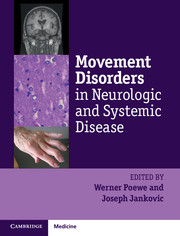Book contents
- Frontmatter
- Contents
- List of contributors
- List of videos
- List of abbreviations
- Preface
- Section I General principles
- Chapter 1 Phenomenology, classification, and diagnostic approach to patients with movement disorders
- Chapter 2 Pathogenesis of movement disorders: basic neuroanatomy and pathophysiology
- Chapter 3 Principles of management in movement disorders
- Section II Movement disorders in systemic disease
- Section III Iatrogenic and toxic movement disorders
- Section IV Movement disorders in general neurology
- Section V Systemic complications of movement disorders
- Index
- Plate Section
- References
Chapter 3 - Principles of management in movement disorders
from Section I - General principles
Published online by Cambridge University Press: 05 April 2014
- Frontmatter
- Contents
- List of contributors
- List of videos
- List of abbreviations
- Preface
- Section I General principles
- Chapter 1 Phenomenology, classification, and diagnostic approach to patients with movement disorders
- Chapter 2 Pathogenesis of movement disorders: basic neuroanatomy and pathophysiology
- Chapter 3 Principles of management in movement disorders
- Section II Movement disorders in systemic disease
- Section III Iatrogenic and toxic movement disorders
- Section IV Movement disorders in general neurology
- Section V Systemic complications of movement disorders
- Index
- Plate Section
- References
Summary
Introduction
Over the past few decades neurology has become a field not only of refined and ever-more precise diagnostics, but has also seen a tremendous growth of its therapeutic armentarium. Movement disorders are a paradigmatic example of this development, with Parkinson’s disease being the first neurodegenerative disease – and still the only one – for which pharmacological substitution of an underlying neurotransmitter defect is able to largely abolish symptoms in the majority of patients for extended periods of time. Effective drug therapies are also available for a variety of other movement disorders, including tremor, chorea, dystonia, tics, or myoclonus. Management of movement disorders, however, goes far beyond medical therapy and includes non-pharmacological measures such as exercise and physical therapies, retraining programmes, biofeedback strategies, as well as occupational and speech therapies. More recently, local chemodenervation of selected muscles using targeted botulinum toxin injections has provided a highly successful new treatment modality for a variety of hyperkinetic focal disorders. Furthermore, functional stereotactic neurosurgery can provide dramatic benefit even in instances of severely disabling drug refractory movement disorder conditions including Parkinson’s disease, essential tremor disorders, and dystonia.
Most, if not all, evidence for efficacy of these different approaches has come from clinical trials in selected, homogeneous populations of subjects with degenerative or idiopathic varieties of the different movement disorder syndromes. There is much less formal evidence to guide treatment decisions in those patients in whom movement disorders appear in the context of systemic diseases or as part of the symptomatic spectrum of general neurological conditions. Managing patients with these types of disorders is, of course, first guided by treatment and – if possible – cure of the underlying condition. In many instances this will not be possible or movement disorders may persist as a sequel of the primary condition. Secondly, symptomatic therapies of the movement disorders must be built on correct phenomenology and classification of the type of movement disorder present or identification of the most relevant disturbance in the setting of mixed movement disorders. Selected treatments will then frequently be those that have been shown to be effective in idiopathic varieties of the same disorder. Thirdly, the management approach will often have to be multimodal, combining non-pharmacological, pharmacological and, less often, neurosurgical approaches, and multidisciplinary, involving not only the primary care physician and a neurologist, but also allied health professionals, including specially trained nurses, psychologists, and physical, occupational, and speech therapists.
- Type
- Chapter
- Information
- Movement Disorders in Neurologic and Systemic Disease , pp. 31 - 38Publisher: Cambridge University PressPrint publication year: 2014



